| |
U.S.-Japan alliance increasingly strengthened since end of WWII
By David Vergun, DOD

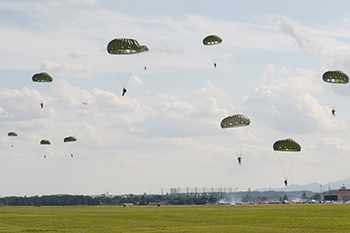
U.S. soldiers with the 1st Battalion, 1st Special Operations Group (Airborne), jump from a C-130 Hercules during the 2015 Japanese-American Friendship Festival at Yokota Air Base, Japan, Sept. 19, 2015. Some 40 U.S. soldiers jumped during the two-day festival, demonstrating Yokota's airdrop capability to the festival attendees. Image by Air Force Staff Sgt. Cody Ramirez |
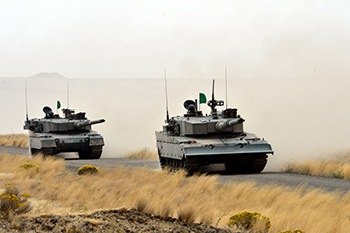
Japanese tanks from the 3rd Combat Team, Japan Ground Self-Defense Force, assault enemy positions during a live fire exercise at the Yakima Training Center, Wash., Sept. 22, 2012. Japanese soldiers of the JGSDF partnered with U.S. soldiers from the 201st Battlefield Surveillance Brigade out of Joint Base Lewis-McChord, Wash., during the exercise, which was the culminating training event of Operation Rising Thunder. Image by Army Sgt. Adam Keith |
As an important ally, Japan increasingly has participated with the United States and other partners in a number of bilateral and multilateral military exercises and operations, especially since the fall of the Soviet Union. For example:
• In the early 1990s, Japan participated in a United Nations peacekeeping operation in Cambodia.
• In November 2001, Japan dispatched the Maritime Self-Defense Force to the Indian Ocean to provide logistical support for U.S. military operations in Afghanistan, marking Japan's first overseas military action during a combat operation.
• In 2003, Japan sent forces to aid in Iraq's postwar reconstruction efforts.
Since 2007, Japan has actively participated in Exercise Malabar with the United States and India.
• The U.S. and Japanese militaries worked effectively together to respond to a March 11, 2011, earthquake and tsunami, which devastated large areas of the main Japanese island of Honshu.
• At the beginning of October 2018, the new Japanese Mobile Amphibious Forces held joint exercises with U.S. Marines in the Japanese prefecture of Kagoshima, the purpose of which was to work out the actions in defense of remote territories.
In recent years, Japan donated dozens of used and new patrol boats to coast guards in the region, complementing similar U.S. efforts toward building partner capacity and capabilities, such as the Indo-Pacific Maritime Security Initiative foreign military financing, international military education and training and the Asia Reassurance Initiative Act.
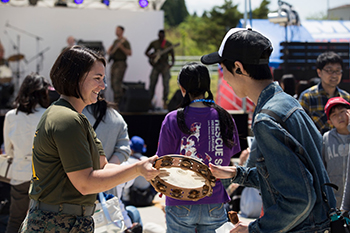
Local residents play a tambourine during the Fuji Flightline Festival at Combined Arms Training Center Camp Fuji, Japan, May 4, 2018. The Flightline Festival is an annual event designed to bring members of the community on base to build relationships, friendships and showcase day-to-day operations. Image by Marine Corps Cpl. Tayler Schwamb |
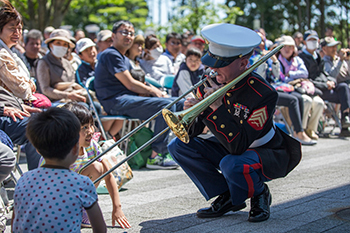
Marine Corps Sgt. Colin Deeter plays his trombone for members of the local community in Shizuoka, Japan, May 4, 2018. The Marines made a point to interact with the audience, giving them instruments to play and performing throughout the crowd. Image by Marine Corps Cpl. Tayler Schwamb |
The depth of the U.S. commitment to the U.S.-Japan alliance is evidenced by the nearly 55,000 U.S. military personnel stationed in Japan, and the thousands of Defense Department civilians and family members who live and work alongside them.
The United States has also deployed its most capable and advanced military assets to Japan, including the Ronald Reagan carrier strike group, two missile defense radar sites and the F-35 joint strike fighter.
Japan acquires more than 90 percent of its defense imports from the U.S. and has expressed growing interest in interoperable technology with advanced capabilities.
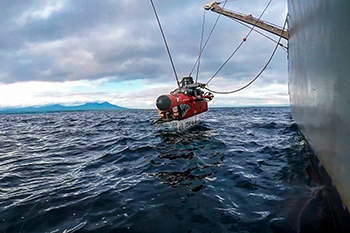
Sailors aboard the USS Pioneer lower a mine neutralization vehicle into the water to get a visual identification of a mine-like object in Mutsu Bay, Japan, July 22, 2020, during Mine Warfare Exercise, an annual training event between the U.S. and Japanese navies. Image by Navy Petty Officer 1st Class Joseph Donaldson |
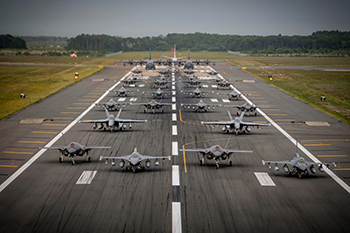
Twelve Air Force F-16CM Fighting Falcons, two Air Force MC-130J Commando II aircraft, two Navy EA-18G Growlers, a Navy C-12 Huron, a Navy P-8 Poseidon and 12 Japan Air Self-Defense Force F-35A Lightning II aircraft participate in an "Elephant Walk” at Misawa Air Base, Japan, June 22, 2020. The event showcased the base’s collective readiness and ability to generate combat airpower at a moment's notice. Air Force Airman 1st Class China Shock |
The United States has approved some $20 billion in foreign military sales to Japan, including Japan's purchase of F-35s, E-2D airborne early warning aircraft, the KC-46 refueling tanker, the Global Hawk unmanned aerial system and MV-22 tilt-rotor aircraft, as well as missiles such as the AIM 120 advanced medium-range air-to-air missile, and UGM-84 Harpoon and SM-3 Block IIA ballistic missile defense interceptor missiles.
The Japanese government provides nearly $2 billion per year to offset the cost of stationing the 55,000 U.S. forces in 85 facilities across Japan.
History of the U.S.-Japan Alliance
After the official surrender of Japan to the Allies on Sept. 2, 1945, the United States began the process of helping to bring Japan back into the international community by strengthening military, political and economic ties, much as it was doing with former foes Italy and Germany.
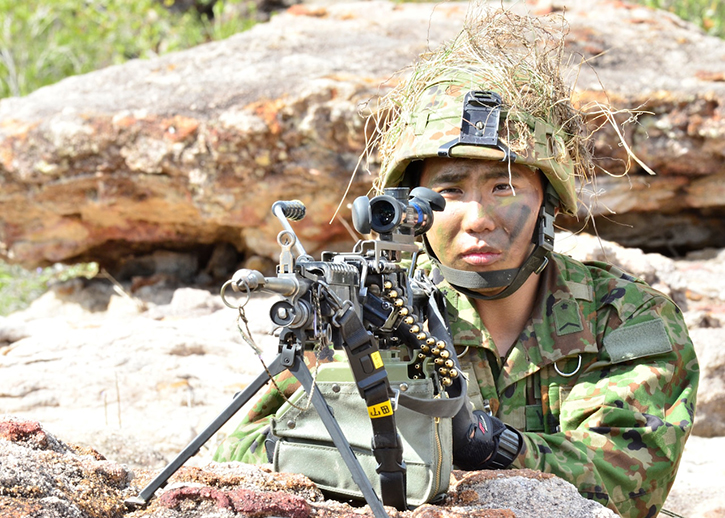
Japan Self-Defense Force Staff Sgt. Itsuya Yamada guards his unit during Exercise Talisman Saber at Shoalwater Bay Training Area, Queensland, Australia, July 14, 2017. Japan was one of five nations participating in this exercise with Australia, the United States, Canada and New Zealand. Image by Army Sgt. Jodi Eastham |
The American military occupation of Japan lasted from 1945 to 1951. During that time, Japan categorically rejected militarism, embraced democracy, eagerly sought economic prosperity and began to embrace the U.S. as an ally and equal partner.
However, the U.S. still occupied several island chains in the Western Pacific that used to be part of Japan. That occupation ended when the U.S. returned the Bonin Islands, including Iwo Jima, to Japan in 1968 and Okinawa and other Ryukyu Islands in 1972.
A series of treaties followed the occupation of mainland Japan. First was the San Francisco Peace Treaty, signed Sept. 8, 1951, that went into effect April 28, 1952. It marked the end of the Allied occupation of the Japanese mainland. Japan's first security agreements with the United States and with nations other than the Soviet Union also were signed then.
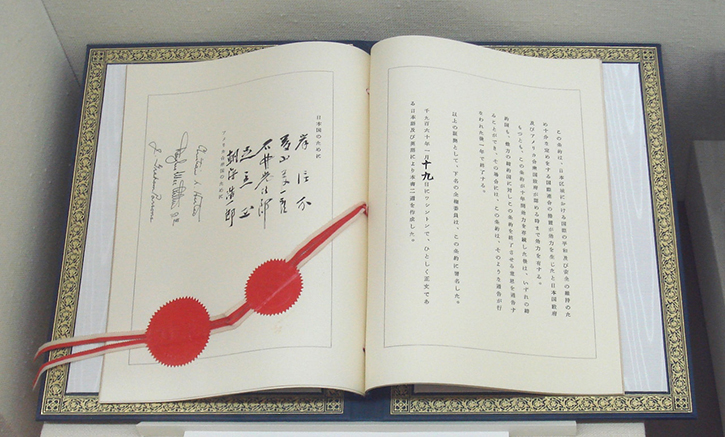
The Treaty of Mutual Cooperation and Security between Japan and the United States, signed in Washington on Jan. 19, 1960. Image courtesy of the State Department |
Bilateral talks on revising the 1952 security pact began in 1959, and the new Treaty of Mutual Cooperation and Security was signed in Washington, Jan. 19, 1960. Also, the status of forces agreement under that treaty came into effect, setting the rules under which U.S. forces stationed in Japan would operate with respect to Japanese domestic laws.
In 1976, the U.S. and Japan established a subcommittee for defense cooperation in the framework of a bilateral Security Consultative Committee, provided for under the 1960 security treaty.
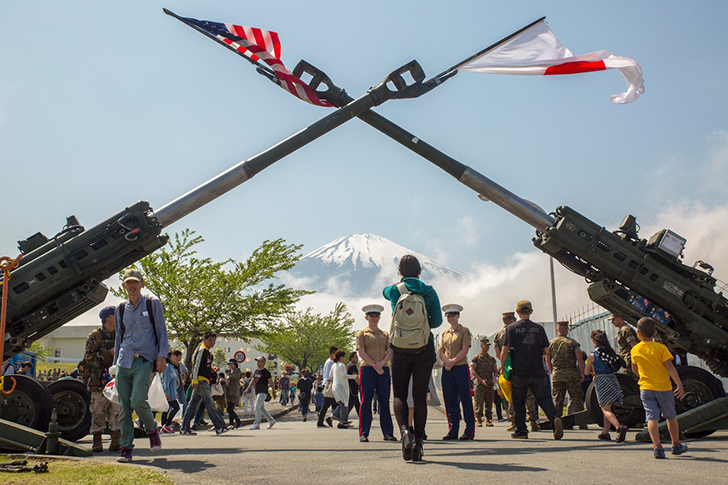
Mount Fuji watches over the Fuji Friendship Festival at Combined Arms Training Center Fuji, Gotemba, Japan, May 7, 2016. The festival included fun and games for all ages and live music from local artists and the U.S. 7th Fleet Band’s Orient Express. Image by Marine Corps Cpl. Janessa Pon |
This subcommittee, in turn, drew up the first guidelines for Japanese-U.S. defense cooperation, under which military planners of the two countries have conducted studies relating to joint military action in the event Japan were to be attacked. The guidelines were updated in 1997 following the collapse of the Soviet Union and the beginning of the "post-Cold War" era. The U.S.-Japan alliance was strengthened further in 2015 through the release of revised guidelines, which provided for new and expanded forms of security-oriented cooperation.
Published August 17, 2020 |

